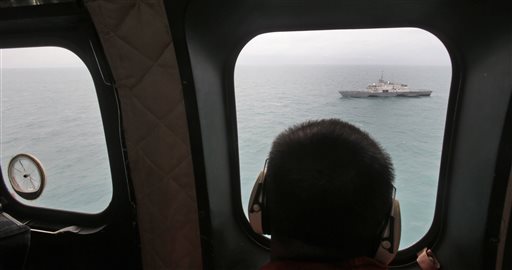
A military ship is seen from Indonesian Air Force NAS 332 Super Puma helicopter during a search operation for the victims of AirAsia Flight 8501, off Pangkalan Bun, Central Borneo, Indonesia, Tuesday, Jan. 6, 2015. AP
PANGKALAN BUN, Indonesia — Strong currents forced Indonesia to expand the search area for the crashed AirAsia plane Tuesday, as rough seas and bad weather pushed debris and made it difficult to reach suspected chunks of the fuselage on the ocean floor.
With only 37 bodies recovered since Flight 8501 crashed Dec. 28, there are also concerns that it will become harder to find the remaining corpses.
“Time is of the essence,” said the National Search and Rescue Agency’s director of operation, Suryadi B. Supriyadi. “But it seems like it is hard to beat the weather.”
The search operation will expand by about 185 square kilometers (71 square miles), search and rescue chief Henry Bambang Soelistyo said.
Indonesia has suffered a string of accidents in recent years. It deregulated its aviation industry in the 1990s, and dozens of new carriers have made air travel affordable for the first time for many in the world’s fourth most populous nation.
Experts say poor maintenance, rule-bending and a shortage of trained personnel are largely to blame. Infrastructure has also failed to keep pace with exploding demand.
The country’s transportation ministry cracked down Monday after it was discovered that Flight 8501 did not have a permit to fly between Surabaya, Indonesia, and Singapore on the day of the crash. The ministry suspended several officials, including the airport operator and those who were in the control tower.
All AirAsia flights on that route also have been canceled, pending an investigation.
It is not known what caused the Airbus A320 to crash into the Java Sea 42 minutes after takeoff, though Indonesia’s Meteorology, Climatology and Geophysics Agency says bad weather appears to have been a factor.
Just before losing contact, the pilot told air traffic control he was approaching threatening clouds, but was denied permission to climb to a higher altitude because of heavy air traffic. No distress signal was issued.
Sonar has identified five large objects that are believed to be pieces of the fuselage on the ocean floor, but strong currents, silt and mud have kept divers from seeing or reaching the objects.
No pings have been detected from the plane’s all-important cockpit voice and flight data recorders. That’s because high waves have prevented the deployment of ships that drag ping locators. The batteries in the pingers on the black boxes are likely to go dead in about 20 more days.
“We are confident that rescuers would be able to locate them in time,” said Nurcahyo Utomo, an investigator for Indonesia’s National Committee on Transportation Safety.
The search for the remaining 125 bodies has been exhausting for family members anxiously waiting to identify and bury their loved ones.
Eight Islamic clerics flew in a helicopter over the site Monday and scattered rice into the sea, a local tradition, and prayed for those who perished.
RELATED STORIES
Indonesia cracks down on aviation sector after AirAsia crash
Doomed AirAsia flight schedule unauthorized—Indonesian transport exec